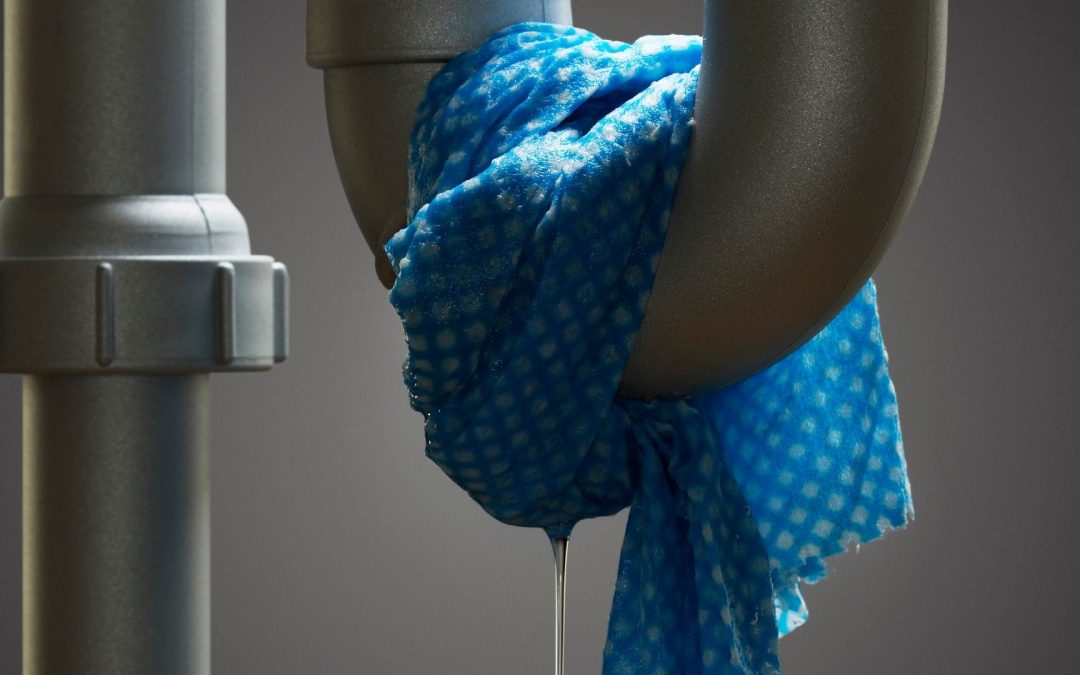A leaky pipe in your kitchen or bathroom causes a bucketful of problems. Accumulating water damages floors and cabinets. Consequently, that moisture provides conditions that are ideal for growing unhealthy mold. A point often overlooked is that the best time to fix a leak in your pipes is before they happen! In other words, be sure to inspect your pipes regularly to be sure all the pipe connections are intact. Whenever you find a loose connection or if you discover a leak, follow these steps for an immediate fix.
Temporary Fix #1 – Threads
Connections of threaded pipes and fittings are prone to leaking if unsealed. To get the most secure seal, follow these steps:
- First, turn off the water supply.
- Be sure the water in the leaky pipe is completely drained.
- Clean and dry the area for the patch.
- Wrap Teflon plumber’s tape clockwise three times around the male threads of the pipe before screwing it together.
- Next, smear Teflon pipe joint compound on top of the plumber’s tape.
- Tighten the connection with two wrenches over the compound and plumber’s tape.
- If you are working with plastic pipes, be sure the compound you are using is compatible with the material and tighten the connection by hand before using wrenches.
- Turn on the water supply and check for leaks.
- Lastly, check for leaks by looking for moisture around the plumber’s tape and compound seals.
Temporary Fix #2 – Tape
Cracks in pipes may also cause a slow leak. If you are not able to replace the pipe right away, self-fusing silicone tape makes an effective temporary solution. The tape creates a waterproof layer when stretched.
- Immediately, turn off the water supply.
- Be sure the leaky pipe is completely drained.
- Clean and dry the area of the leak.
- Wrap the tape around the pipe.
- Be sure that the tape is stretched.
- Furthermore, overlap the tape over the damaged area of the pipe.
- Follow the manufacturer’s instructions.
- Turn on the water supply and check for leaks.
- Check for leaks by looking for moisture around the tape.
Temporary Fix #3 – Tape
Fiberglass tape is flexible and easy to use. It is designed to harden when it has had the proper amount of exposure to moisture.
- Turn off the water supply.
- Be sure the involved pipes are completely drained.
- Clean and dry the leaking pipe.
- Wrap the tape around the pipe.
- Stretch the tape tightly.
- Overlap the tape over the damaged area of the leaky pipe.
- Follow the manufacturer’s instructions.
- Turn on the water supply and check for leaks.
- Check for leaks by looking for moisture around the tape.
Temporary Fix #4 – Putty
Another temporary repair is to use epoxy or pipe putty. Putty is designed to harden at room temperature and seal a hole or crack in a leaky pipe. Follow these steps:
- Turn off the water supply.
- Be sure the involved pipes are completely drained.
- Clean and dry the area requiring the patch.
- Tear off enough putty to fully cover the surface around the leak.
- Knead the putty until it is pliable and easy to apply.
- Apply the putty to the pipe to completely cover the entire area of the leak.
- Allow the putty to completely cure according to the manufacturer’s instructions before turning the water supply back on.
- Turn on the water supply and check for leaks.
- Check for leaks by looking for moisture forming on the edges of the epoxy putty.
Temporary Fix #5 – Patch and Clamp
Repair clamps and neoprene rubber patches will make a temporary repair to larger ruptures in a leaky pipe. Follow these steps:
- Turn off the water supply.
- Be sure the involved pipes are completely drained.
- Clean and dry the area to be patched.
- Use a metal file and/or sandpaper to smooth any sharp places on the damaged pipe that could cause a tear in the patch
- Wrap the neoprene patch around the leaky pipe so that it overlaps the damaged area of the pipe evenly.
- You may want to use tape to hold the patch in place until you tighten the clamps.
- Tighten the clamps around the rubber patch to seal the leaky pipe.
- You can remove the tape once the clamps are tight.
- Turn on the water supply and check for leaks.
- Check for leaks by looking for moisture around the where the rubber patch is in contact with the pipe.
Temporary (Or Permanent!) Fix #6 – Slip Couplings
Slip couplings are small watertight connections that can connect 2 different pieces of pipe. A slip coupling can be a permanent solution to fixing a damaged pipe as long as they are up to code in your community.
- Without delay, turn off the water supply.
- It’s important to drain the pipe completely.
- Clean and dry the area requiring repair.
- Mark the pipe on either side of the damage to be sure that the coupling will fit.
- Use a pipe cutter to cut the pipe on the marks.
- Equally important, use a deburring tool to scrap the inside and outside of the pipe to reshape it after after the cut and make it less jagged.
- Then, slide the coupling over the ends of the open pipe.
- Push the coupling so that it is equally overlapping both broken sides of the pipe.
- Tighten the coupling by hand or with a wrench following the manufacturer’s instructions.
- Turn on the water supply and check for leaks.
- Check for leaks by looking for moisture around the edges of the coupling.
Clean Up After Repairing That Leaky Pipe!
After stopping the leak, the task is only half complete however. That is to say you need to take care of the mess caused by the leak and the repair.
- To begin, remove all items out of any cabinets or around the leak.
- Next, soak up any excess water with towels or sponge.
- Wipe and mop floors.
- Wipe down the interior surfaces of the cabinets.
- A point often overlooked, use a disinfectant cleaner to disinfect all surfaces.
- Make your own disinfectant solution with 1 ounce bleach to 4 gallons of hot water.
- Finally, leave all surfaces out in the open and all doors open to dry completely.
- Using a hair dryer, fan, or dehumidifier will help it all dry quickly.
- Once all the surfaces are completely dry, inspect the cabinets and floors for any damage such as saturation of particle board or warping.
Knowing how to fix a leaky pipe saves time and money, but remember that repair tape, pipe putty, and clamps are temporary solutions. Therefore, after sealing a leaky pipe, your next step is just as important: Make plans for a permanent repair even if it’s a small leak. Give the professionals a call at Fite Plumbing at (317) 271-5400 and we can help ensure that your seals are secure, and your home will stay dry.
Are you on Facebook? We are, too. Let’s be friends!


